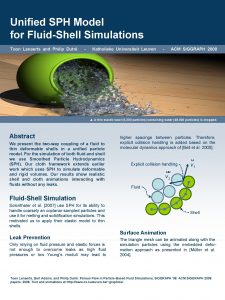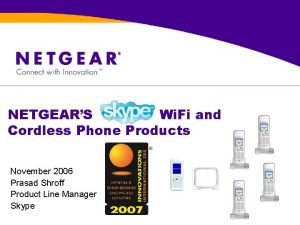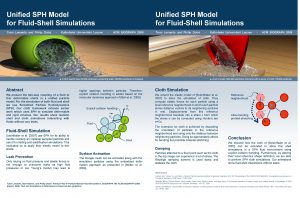Unified SPH Model for FluidShell Simulations Toon Lenaerts


- Slides: 2

Unified SPH Model for Fluid-Shell Simulations Toon Lenaerts and Philip Dutré - Katholieke Universiteit Leuven - ACM SIGGRAPH 2008 ▲ A thin elastic bowl (5, 300 particles) containing water (48, 000 particles) is dropped. Abstract We present the two-way coupling of a fluid to thin deformable shells in a unified particle model. For the simulation of both fluid and shell we use Smoothed Particle Hydrodynamics (SPH). Our cloth framework extends earlier work which uses SPH to simulate deformable and rigid volumes. Our results show realistic shell and cloth animations interacting with fluids without any leaks. higher spacings between particles. Therefore, explicit collision handling is added based on the molecular dynamics approach of [Bell et al. 2005]. Explicit collision handling Fluid-Shell Simulation Solenthaler et al. [2007] use SPH for its ability to handle coarsely an coplanar sampled particles and use it for melting and solidification simulations. This motivated us to apply their elastic model to thin shells. Leak Prevention Only relying on fluid pressure and elastic forces is not enough to overcome leaks as high fluid pressures or low Young’s moduli may lead to Shell Surface Animation The triangle mesh can be animated along with the simulation particles using the embedded deformation approach as presented in [Müller et al. 2004]. Toon Lenaerts, Bart Adams, and Philip Dutré: Porous Flow in Particle-Based Fluid Simulations, SIGGRAPH '08: ACM SIGGRAPH 2008 papers, 2008. Text and animations at http: //www. cs. kuleuven. be/~graphics/

Unified SPH Model for Fluid-Shell Simulations Toon Lenaerts and Philip Dutré - Katholieke Universiteit Leuven - ACM SIGGRAPH 2008 ▲ A jet of water (300, 000 particles) interacts with a piece of cloth (15, 000 particles) Cloth Simulation We extend the elastic model of [Solenthaler et al. 2007] to allow the simulation of cloth. They compute elastic forces for each particle using a local reference neighborhood in which each particle stores distance vectors to its neighboring particles in rest. Displacements from this reference neighborhood translate into a strain ε from which the stress σ can be computed using Hooke’s law σ=Cε. The extension for cloth is achieved by discarding the orientation of particles in the reference neighborhood and using only the distance between neighboring particles. Doing so appropriately allows for bending but prohibits material stretching. Damping Particles attached to a fixed point such as the cloth in the top image can experience a lot of stress. The Rayleigh damping scheme is used damp and stabilize the cloth. Reference neighborhood Allow bending, prohibit stretching Conclusion We showed how the work of [Solenthaler et al. 2007] can be extended to allow thin shell simulations in a SPH fluid environment using explicit collision handling. Furthermore, by altering their local reference shape definition, we are able to perform SPH cloth simulations. Our animations show fluid-shell interactions without leaks. References Nathan Bell, Yizhou Yu, and Peter J. Mucha: Particle-based simulation of granular materials, SCA '05: Proceedings of the 2005 ACM SIGGRAPH / Eurographics symposium on Computer animation, ACM Press, 77 -86, 2005 Matthias Müller, Richard Keiser, Andy Nealen, Mark Pauly, Markus Gross, and Marc Alexa: Point-based animation of elastic, plastic and melting objects, Proceedings of 2004 ACM SIGGRAPH Symposium on Computer Animation, 141 -151, 2004 Barbara Solenthaler, Jürg Schläfli, and Renato Pajarola: A unified particle model for fluid-solid interactions, Computer Animation and Virtual Worlds 18(1), John Wiley and Sons Ltd. , 69 -82, 2007



